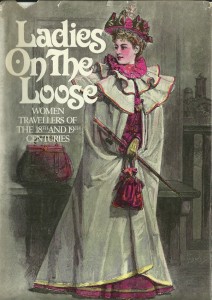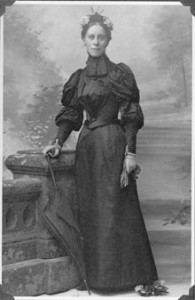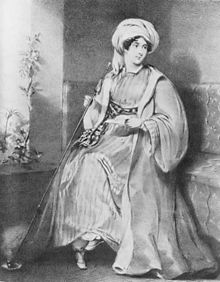Libri/Donne erranti – di Mariangela Venezia
New York di maggio è piena di sole, vago per le strade  bevendo la primavera come una bibita rinfrescante. Un negozio vintage, una partita a scacchi nel parco, un sassofonista sulle scale del Metropolitan, un chiosco che vende il milk shake al gusto passion fruit. E poi Strand, all’angolo tra la dodicesima strada e Broadway. Infiniti corridoi e migliaia di libri. Curiosando, chiedendo, cercando, scopro una minuscola sezione tra la letteratura e il viaggio piena di vecchi libri, remainders e pubblicazioni out of print. È così che trovo Ladies on the loose (edited by Leo Hamalian, Dodd, Mead & Company, New York, 1981), storie di donne con la valigia tra il diciottesimo e il diciannovesimo secolo. Mi siedo su una panchina al sole, e con loro, continuo a viaggiare.
bevendo la primavera come una bibita rinfrescante. Un negozio vintage, una partita a scacchi nel parco, un sassofonista sulle scale del Metropolitan, un chiosco che vende il milk shake al gusto passion fruit. E poi Strand, all’angolo tra la dodicesima strada e Broadway. Infiniti corridoi e migliaia di libri. Curiosando, chiedendo, cercando, scopro una minuscola sezione tra la letteratura e il viaggio piena di vecchi libri, remainders e pubblicazioni out of print. È così che trovo Ladies on the loose (edited by Leo Hamalian, Dodd, Mead & Company, New York, 1981), storie di donne con la valigia tra il diciottesimo e il diciannovesimo secolo. Mi siedo su una panchina al sole, e con loro, continuo a viaggiare.
Vita in Libano (Lady Hester Stanhope)
Tratto da Memorie (1845)
Traduzione di Mariangela Venezia
“If you were a man, I would send you on the Continent with sixty thousand men, and give you carte blanche; and I am sure that no none of my plans would fail, and no one soldier would go with his shoes unblackened” (Uncle William)
(…) Sono andata una settimana nel deserto con il “capo tribù”, Mahannah el Fadel (che comanda 40,000 uomini), e ho camminato per tre giorni con la sua carovana. Sono stata trattata con enorme rispetto e ospitalità, e ho visto le cose più strane che abbia mai visto in vita mia; cavalli e giumente nutrite di latte di cammello; arabi il cui sostentamento è fatto di riso e poco altro; la natura, intorno a me, ricoperta di vita: i vecchi poeti sulle rive dell’Eufrate che cantano le gesta degli antichi eroi; le donne con le labbra tinte di azzurro brillante e le unghie di rosso e le mani decorate di fiori e altre forme; un capo a cui si obbedisce come a un grande re; un insieme di miseria e orgoglio che mai avrei potuto immaginare… Tuttavia, ho tutte le ragioni per essere pienamente soddisfatta del loro comportamento nei miei confronti, e io sono la loro regina. (…)
(…) I went with the great chief, Mahannah el Fadel (who commands 40,000 men), into the desert for a week, and marched for three days with their camp. I was treated with the greatest respect and hospitality, and It was the most curious sight I ever saw; horses and mares fed upon camel’s milk; Arabs living upon little else except rice; the space around me covered with living things; 1600 camels coming to water from one tribe only; the old poets from the banks of the Euprhates singing the praises of the ancient heroes; women with lips dyed brigt blue, and nails red and hands all lover flowers and different designs; a chief who is obeyed like a great king; starvation and pride so mixed that really I could not have had an idea of it…However, I have every reason to be perfectly contented with their conduct toward me, and I am the Queen with them all. (…)
Lady Hester Stanhope (1776-1839), figlia di un eccentrico inventore e nipote del primo conte di Chatman, dopo molti anni trascorsi in ritiro in un cottage del Galles decide che l’Inghilterra è troppo piccola e nel 1810, accompagnata dal fratello, parte per il Medio Oriente. Vive ad Atene, Costantinopoli, in Egitto, Libano e Siria. Attraversa il deserto siriano verso Palmyra (dove diventa nota come la regina di Palmyra), stringe amicizia con i beduini, vivendo nelle loro tende e fumando l’hookah. La sua corrispondenza privata è stata pubblicata nel 1845 in tre volumi da Charles Meryon con il titolo The Memoirs of Lady Hester Stanhope, As Related Herself in Conversation With Her Physician, Comprising Her Opinions and Anectodes of Some of the Most Remarkable Pearsons of Her Time.
Viaggio nella giungla (Mary Kingsley)
Tratto da Viaggi in Africa occidentale (1897)
Volli andare nel Congo Francese per svegliarmi sulle rive del Ogowé e trovare pesci per la mia collezione. Volevo prenderli in un fiume a nord del Congo, avevo sperato che fosse il Niger poiché Sir George Goldie aveva disposto tutto per facilitarmi, ma per mie ragioni private mi dissuasi dall’andare dal Royal Niger Protectory al territorio del Royal Niger Company; Sir Claude MacDonald fece di tutto per assistermi, ma nemmeno il Calabar si rivelò un buon fiume per pescare. Dalla natura di questi due fiumi sentendomi tradita, riposi tutte le mie speranze nel fiume della costa sud-occidentale; l’Ogowé. Alta o bassa marea l’acqua è sempre la stessa; che il fiume sia ampio o stretto, di alti o bassi fondali, sembra un sentiero di metallo lucido; perché è costantemente pieno di fango maleodorante con la bassa e alta marea, anno dopo anno. Ma la differenza tra le due sponde, in un’infinita alternanza di apparenze, è piuttosto strana. Con l’alta marea non si vedono le mangrovie che mostrano le caviglie, cosa che scioccò il Capitano Lugard. Sembrano più rispettabili, il fogliame si innalza rigoglioso come su un muro striato irregolarmente qua e là dalla linea bianca delle radici aeree, cadendo a picco nell’acqua dal ramo più alto come se crollassero, nello strano modo delle mangrovie, mantenendosi diritte fino quasi a toccare l’acqua per aprirsi a pochi centimetri come mani appuntite che si immergono nell’acqua per acchiappare il fango. Con l’acqua alta invece le sponde a stento si vedono, solo distese d’acqua nelle paludi di mangrovie per miglia e miglia. Si può andare in canoa tra queste paludi, è affascinante. Per le persone che amano queste cose è come essere il critico d’arte di una cittadina di provincia che osserva un quadro impressionista appena acquistato dal museo comunale, ma è un piacere da godere con prudenza perché di sicuro si incappa nei coccodrilli. Finché il coccodrillo se ne sta tranquillo nell’acqua o addormentato con le fauci aperte sulla sponda, nel sole, fa parte del paesaggio, se sei sul ponte di un vaporetto e puoi scrivere a casa per spaventare i tuoi famigliari. Ma quando sei nella palude su una canoa e i coccodrilli sono svegli – ad esempio quando c’è l’alta marea e ci sono più pesci in giro – e quando risvegliano il loro istinto e scalpitano con la coda nel fango – è molto interessante perché potresti non raccontarlo e hai paura. I coccodrilli infatti possono, in questi luoghi, attaccare le persone nelle piccole canoe. Ho saputo di molti indigeni morti così; alcuni villaggi sono facilmente raggiungibili dal fiume attraverso le paludi di mangrovie e gli abitanti lo percorrono con piccole canoe invece che attraversare il canale che porta al villaggio, che è quasi sempre ventoso. Oltre a questo contrattempo – a meno che non fai tesoro dell’esperienza o un indigeno ti avverte – potresti impantanarti nella palude, con l’acqua che ricopre la piccola conca o la laguna dove ti trovi senza che tu possa tornare al fiume. Non puoi scendere e trascinare la tua canoa nel fango che ti separa dal fiume perché il fango è troppo molle e profondo e annegheresti, restando lì finché qualche geologo dal futuro ti trova fossilizzato, quando le paludi di mangrovie saranno diventate un deserto. Di certo se cerchi la gloria e vuoi lasciare una traccia ai posteri e alla scienza futura, ti butterai nel fango denso, rallegrato dal pensiero della sorpresa di chi ti troverà tra ventimila anni e delle attenzioni che i tuoi simili ti riserveranno in un museo. Ma se sei una persona comune e di natura riservata come me ti fermerai nella tua laguna fino a che non si alza la marea; ti concentrerai su come tornare a casa tra i coccodrilli, le paludi di mangrovie e il tanfo di fango. Ti chiederai perché sei venuta nell’Africa occidentale e hai toccato un tale livello di assurdità, e perché ti è venuto in mente di lasciare la pittura e il giardinaggio per essere così stupida da avventurarti nelle paludi di mangrovie. (…)
My main aim in going to Congo Français was to get up above the tide line of the Ogowé River and there collect fishes; for my object on this voyage was to collect fish from a river north of the Congo. I had hoped this river would have been the Niger, for Sir George Goldie had placed at my disposal great facilities for carrying on work there in comfort; but for certain private reasons I was disinclined to go from the Royal Niger Protectorate into the Royal Niger Company’s territory; and the Calabar, where Sir Claude MacDonald did everything he possibly could to assist me, I did not find a good river for me to collect fishes in. These two rivers failing me, from no fault of either presiding genii, my only hope of doing anything now lay on the South West Coast river; the Ogowé. High–tide or low–tide, there is little difference in the water; the river, be it broad or narrow, deep or shallow, looks like a pathway of polished metal; for it is as heavy weighted with stinking mud as water e’er can be, ebb or flow, year out and year in. But the difference in the banks though an unending alternation between two appearances, is weird.
At high–water you do not see the mangroves displaying their ankles in the way that shocked Captain Lugard. They look most respectable, their foliage rising densely in a wall irregularly striped here and there by the white line of an aërial root, coming straight down into the water from some upper branch as straight as a plummet, in the strange, knowing way an aerial root of a mangrove does, keeping the hard straight line until it gets some two feet above water–level, and then spreading out into blunt fingers with which to dip into the water and grasp the mud. Banks indeed at high water can hardly be said to exist, the water stretching away into the mangrove swamps for miles and miles, and you can then go, in a suitable small canoe, away among these swamps as far as you please.
This is a fascinating pursuit. For people who like that sort of thing it is just the sort of thing they like, as the art critic of a provincial town wisely observed anent an impressionist picture recently acquired for the municipal gallery. But it is a pleasure to be indulged in with caution; for one thing, you are certain to come across crocodiles. Now a crocodile drifting down in deep water, or lying asleep with its jaws open on a sand – bank, in the sun, is a picturesque adornment to the landscape when you are on the deck of a steamer, and you can write home about it and frighten your relations on your behalf; but when you are away among the swamps in a small dug – out canoe, and that crocodile and his relations are awake – a thing he makes a point of being at flood tide because of fish coming along – and when he has got his root upon his native heath – that is to say, his tail within holding reach of his native mud – he is highly interesting, and you may not be able to write home about him – and you get frightened on your own behalf. For crocodile can and often do, in such places, grab at people in small canoes. I have known of several natives losing their lives in this way; some native villages are approachable from the main river by a short cut, as it were, through the mangrove swamps, and the inhabitants of such villages will now and then go across this way with small canoes instead of by the constant channel to the village, which is almost always winding. In addition to this unpleasantness you are liable – until you realise the danger from experience, or have native advice on the point – to get tide – trapped away in the swamps, the water falling round you when you are away in some deep pool or lagoon, and you find you cannot get back to the main river. For you cannot get out and drag your canoe across the stretches of mud that separate you from it, because the mud is of too unstable a nature and too deep, and sinking into it means staying in it, at any rate until some geologist of the remote future may come across you, in a fossilised state, when that mangrove swamp shall have become dry land. Of course if you really want a truly safe investment in Fame, and really care about Posterity, and Posterity’s Science, you will jump over into the black batter – like, stinking slime, cheered by the thought of the terrific sensation you will produce 20,000 years hence, and the care you will be taken of then by your fellow – creatures, in a museum. But if you are a mere ordinary person of a retiring nature, like me, you stop in your lagoon until the tide rises again; most of your attention is directed to dealing with an “at home” to crocodiles and mangrove flies, and with the fearful stench of the slime round you. What little time you have over you will employ in wondering why you came to West Africa, and why, after having reached this point of absurdity, you need have gone and painted the lily and adorned the rose, by being such a colossal ass as to come fooling about in mangrove swamps.(…)
 Mary Kingsley (1862-1900), scrittrice e viaggiatrice, si reca per la prima volta in Africa occidentale con la piccola somma di denaro ereditata alla morte del padre, fisico e viaggiatore. Colleziona moltissimi pesci di specie fino a quel momento sconosciute in Europa e i suoi racconti di viaggio denunciano le condizioni di schiavitù in cui i coloni europei tenevano gli africani. È la prima donna ad arrampicarsi sul Monte Cameroon, ritenuto pericoloso e inaccessibile persino dai nativi africani. Tra i suoi libri: Travels in West Africa (1897), West African Studies (1899), Notes on Sport and Travel (1900).
Mary Kingsley (1862-1900), scrittrice e viaggiatrice, si reca per la prima volta in Africa occidentale con la piccola somma di denaro ereditata alla morte del padre, fisico e viaggiatore. Colleziona moltissimi pesci di specie fino a quel momento sconosciute in Europa e i suoi racconti di viaggio denunciano le condizioni di schiavitù in cui i coloni europei tenevano gli africani. È la prima donna ad arrampicarsi sul Monte Cameroon, ritenuto pericoloso e inaccessibile persino dai nativi africani. Tra i suoi libri: Travels in West Africa (1897), West African Studies (1899), Notes on Sport and Travel (1900).

